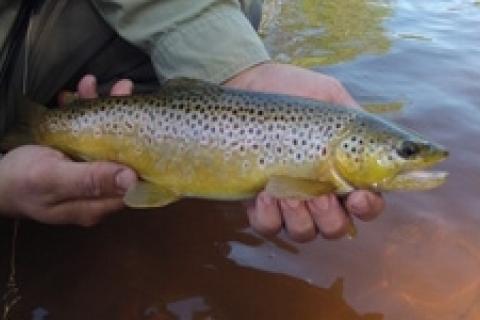
 Wisconsin is known for its pristine water ways that combine great water quality and high nutrient load, making them very susceptible to harboring large amounts of aquatic invertebrates. Sowbugs are a group of aquatic invertebrates that happen to be one of the most important food sources available for trout throughout Wisconsin streams and rivers. These critters are often favored by big fish because they offer a hefty supply of protein and nutrients for fish, and are a pattern that fly fishermen should get to know well.
Wisconsin is known for its pristine water ways that combine great water quality and high nutrient load, making them very susceptible to harboring large amounts of aquatic invertebrates. Sowbugs are a group of aquatic invertebrates that happen to be one of the most important food sources available for trout throughout Wisconsin streams and rivers. These critters are often favored by big fish because they offer a hefty supply of protein and nutrients for fish, and are a pattern that fly fishermen should get to know well.
Sowbugs are very similar in size, color and shape to scuds. Both of these invertebrates fall in the nymph category, but unlike other nymphs they remain in the water year round. The sowbugs entire life cycle is spent in the water, making fishing these patterns a possibility any time during the year. As a result, there is never any doubt whether they will be in the water. In many cases, fly anglers can start out with some type of sowbug as a searching pattern when they are not sure of what is hatching, or when fishing new waters. Since trout are always on the feed for sow bugs; you get the chance to fish and do a little research at the same time. If you catch a trout on a sow you can do a quick stomach pump and see what they are eating and if not you can look for hatches throughout the day as you fish with a pattern you know fish will be interested in.
Fishing sowbugs is similar to fishing many other traditional nymph patterns. In most cases you should fish sow patterns dead drifted using and up and across casting pattern. Fish this pattern methodically and slow across a deep pool or rocky run. Fish will not always chase for sowbugs, but if you put it on their nose there is a good chance they will bite! One important point to remember when fishing sowbugs is if you do not get a strike dead drifting the fly, then switching from the up and across presentation to an active downstream approach might do the trick. For the downstream technique, cast the fly at a 45-degree angle downstream of your position. After the fly has touched down and sank for a few seconds, strip the fly across the current. Use erratic stripping motions from 6 inches to one foot with the fly coupled with short pauses.
If you haven't tried fly fishing with sowbugs you are missing out on the chance to target one of the largest food sources of trout. These patterns are consistent producers that can be used all year long and are a valuable addition to fisherman's fly boxes.
- 3666 views

